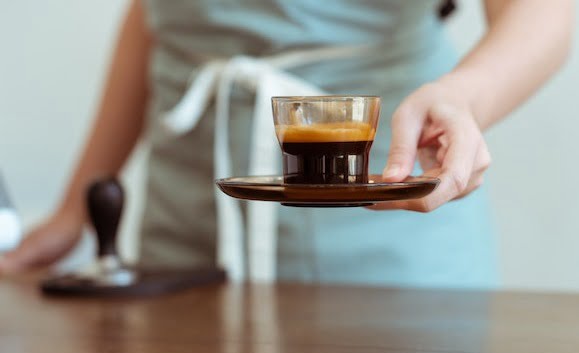The best temperature for Espresso is between 195°F and 205°F (90°C to 96°C). This temperature range ensures the grounds are extracted properly, producing a flavorful and balanced shot.
Too hot and you’ll scorch those delicate coffee oils, leaving a bitter mess. Too cold and you’ll underextract, ending up with a thin and watery shot.
In this article, I will discuss how water temperature affects the extraction of espresso, the ideal water temperature for espresso, how to measure the temperature, and many more tips.

how does the temperature affect the Extraction of Espresso?
Water temperature is crucial in the process of making espresso as the temperature affects how quickly and efficiently the water extracts the flavor and aroma from the coffee grounds.
According to the National Coffee Association, the ideal temperature for brewing coffee is between 195°F and 205°F (90°C-96°C).
When the water is at the ideal temperature, it can extract the flavors and aroma from the coffee grounds, resulting in a balanced and rich taste.
If the water is too hot, it can cause the espresso to taste burnt or bitter, and if it’s too cold it can result in a sour or weak shot.
The temperature of the water also affects the texture of the espresso. The ideal temperature helps to create a rich and full-bodied texture of the espresso shot.
If the water temperature is too low, the espresso shot will have a thin layer of crema and watery texture, while if it’s too high, it can result in a harsh and rough texture.
While using dark roasted beans start from the lower end of the ideal temperature range i-e 190-195 degrees and for light roasted beans start from the higher end i-e 205 degrees and tweak the temperature from there to achieve the perfect taste. That’s because dark roasted beans extract flavors more quickly and easily than light roasted beans.
How to measure temperature in a Home Espresso machine?
Most espresso machines come with a built-in thermometer or a temperature gauge, which measures the temperature of the water in the machine.
If your machine does not have a built-in thermometer, you can use a thermometer to measure the temperature of the water.
To measure the water temperature, you can hold it under the group head to check the temperature of the water as it flows through the coffee grounds.
Can you adjust the water temperature in a home Espresso Machine?
Yes, you can adjust the water temperature in your home espresso machine with PID Controllers. These espresso machines come with a temperature dial or control, which allows you to adjust the water temperature to your desired level.
The process for adjusting the temperature on an espresso machine can vary depending on the make and model of the machine and generally, you can find all the information related to it in the user manual.
However, most entry-level home espresso machines operate only on the preset temperature, and the users can’t play with temperatures.
When adjusting your espresso brewing temperature, make sure to add at least 2-degree increments in order to experience a noticeable change.
What is the Best Milk Temperature for Espresso
The ideal temperature for steaming milk is between 140°F and 155°F (60°C-68°C) for latte and cappuccino. For a flat white, the ideal temperature is between 130°F and 140°F (54°C-60°C).
Steaming milk at too high a temperature can denature the milk proteins, leading to a burnt taste. Moreover, overheating milk can also cause lactose to break down into glucose and galactose, resulting in a sweeter taste that may not be desirable in espresso-based beverages.
And If the milk is steamed at too low a temperature, the drink will lack the creamy mouthfeel and velvety texture that make these beverages so enjoyable.

What’s the best serving temperature for Espresso?
The ideal serving temperature for espresso is between 155°F and 175°F (68°C-79°C). This temperature range allows the flavors and aromas of the espresso to be fully appreciated while also preventing the drink from being too hot to drink.
I can say that as an espresso lover, serving it at the right temperature and drinking it immediately after brewing is crucial for enjoying the best flavors. Espresso should be served immediately after brewing, and ideally, it should be consumed within 30 seconds to one minute.

Final Thoughts
While Dialing in the process of Espresso making, it’s important to think about temperature at the last.
As long as the water temperature for Espresso is in the ideal range of 195-205 degrees you don’t need to be too fussy about that. As changing temperatures in Home Espresso machines is not mostly possible and for commercial espresso machines with multiple group heads it will not be feasible.
First play with other variables like grind size, dose, and yield. You can tell the machine needs temperature adjustment if you experience bitterness and acidity time and time again.
So keep practicing and Cheers to a perfect shot of espresso!



